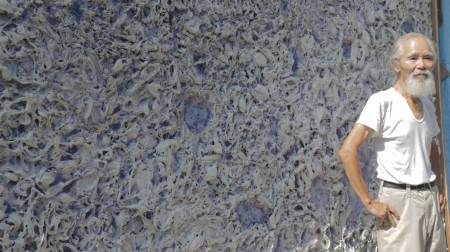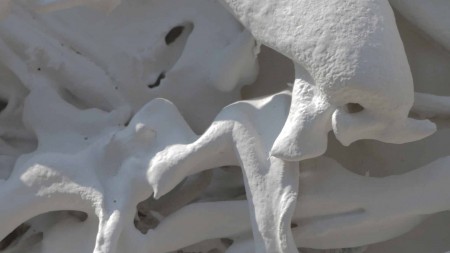His art is created in a compact 2–building atelier with a circular yard fringed by manicured black pines. The yard’s entrance faces southwest at the foot of Fukui’s Mt. Hachiman, one of three mountains clustered just south of the Asuwa River, and from which the renowned blue shakudani stone has been mined for 1,500 years. Using a Fresnel lens, originally designed for lighthouses, Tatsuya Tatsuta focuses the sun’s energy up to 2000 OC, and material transformations occur.
Bombs destroyed over 80% of Fukui City in 1945. Just 3 years later, when Tatsuya was 1 year old, a magnitude 7.1 earthquake struck at the center of the city, collapsing 79% of buildings and killing thousands. The city has since adopted the emblem of the phoenix.
When I prod him directly about the ideas behind his work, he invariable answers in material, instrumental terms. “It is about picking up concrete things that exist in front of our eyes. That is what infants do. They suck, they tap, they smash and so on, and before long they expect they can draw out its voice. Good artistic creations have their idea in the distant background; they can stand alone in their own right”
Tatsuya takes us on a tour of Fukui. At the Osagoe Minkaen folk village we enter the A-frame gassho house and former residence of the Jochi family of Ono city, and sit on the cool boards around a pit of ashes that he cannot resist disturbing with the tongs at hand, sifting for embers. Ever voluble, his piercing eyes of wonder never seem to rest. Using hands and shoulders to conduct his speech, his wire-thin body moves faster than any of us can believe for a man of 69. He is polite and humble, grateful for everything. ‘I want to envelop the globe in my arms,’ he says, ‘and give thanks.’
Inspired by Wassily Kandinsky, some of whose abstract works were curated in an exhibition held at the Fukui City Art Museum along with those of Paul Klee in 2009, there is something uniquely different about Tatsuya’s Re-Monad that positions it between abstract painting and sculpture. “It is in the transformation,” he hints. After meeting Tatsuya, one might also believe that it is in the important element of physical touch inherent to all plastic arts; his results are wrought from the combined force of nature’s energy and human contact applied to things “picked up in front of the eyes.” I think of the scorched plastic and other materials of Alberto Burri, and my own obsession with texture, which first drew me to Tatsuya’s work.
At the A-house, Tatsuya touches the enormous zelcova single-bole cross-beams, shaped by thousands of single hand-strokes using a Japanese adze. He mimics the laborious motion. Back at his atelier he suddenly produces a gleaming adze from beside the sink and demonstrates the craft on a piece of wood. The chips fall, we notice, within the white rectangle of concrete framed by the black soot where his Fresnel lens and stage usually stand. His father, Tatsuya tell us, was a miyadaiku: a carpenter of temples.
His 4-piece work collectively entitled Re-Monad (1-4), first exhibited at Tokyo’s National Art Center in February 2016, was influenced by a tour of the disaster stricken areas of Tohoku after the Great East Japan Earthquake and tsunami of March 11 2011, the images of which continue to haunt him.
Record flooding in 2004 destroyed most of his works and prompted a turn towards water-resistant materials. He began working with polystyrene foam salvaged from the local supermarket. “It was a period of total exhaustion in the face of the realities of life,” he says, looking back to that time, and remembering how frantically he had worked, like “a drowning man clutching at a straw.”
But it was the image of the ‘Elephant’s Foot’ – meltdown lava from the Chernobyl nuclear reactor – re-printed in the Asahi newspaper in 2006 that shaped his vision of co-expressing “what can be seen with the eyes and what can not be,” that would later attain refinement in Re-Monad. “Fukui has 13 nuclear power plants,” he informs me, “and a nest of earthquake faults beneath them”.
When I broach the subject of making a connection between trauma and texture, he concedes that “there may be a relationship to texture. The process of abstract modeling in the plastic arts cannot indicate the traces (of trauma), but this might be something that can be seen and felt from the whole.”
Seen side by side, movement in these large works, from white/smooth (Re-Monad 4) through darkly variegated/rough (Re-Monad 1), appears like the collapse into chaos described by those who have experienced pavor nocturnus or ‘night terrors’, a sense of acceleration from a fragile peace into what is both terrifying and infinite. Even within Re-Monad 1, the densest piece, there appears to be movement from the extremities to the center, as if there were still some hope to be crushed at this late stage of devastation. When I put this to him he explains, “I could regulate the obtrusion by the use of color. There is a difference when you see the whole or the partial work. The parts must be balanced as a whole, even when it is something chaotic.” This precarious balance between the partial and the whole in Re-monad is perhaps the source of its terrifying power.
At the gallery of his patron Ms. Ogura, Tatsuya points to a box with 3 stone heads of deities that reminds me of the Japanese proverb san nin yoreba Monju no chie (three heads equal the wisdom of Monju). Monju, perversely, is the name given to the hapless nuclear power plant nearby in Tsuruga. The heads were recovered from the ruins of the Echizen Asakura clan in Ichijodani. The major city of 10,000 was destroyed in 1573 by a devastating 3 day-and-night attack by Oda Nobunaga, soon after which the capital was moved from Kyoto to Edo (Tokyo). Tatsuya prefers the head with the twisted countenance, which also happens to have a large piece broken off. It evokes Michelangelo, he tells us, whose dictum “the steps I take every day are my destination” is close to his own heart.
“I love stones so much,” he says, “I once tried to eat them,” and then laughs to reveal his several damaged teeth.
A documentary film, Re-Monad: Infinite Chaos, based on Tatsuya Tatsuta’s work and its relevance to somatic encoding of trauma, is scheduled for completion in 2017. A trailer may be viewed at: https://www.youtube.com/watch?v=FhpjnRX6SqM
Tatsuya Tatsuma’s next exhibition will be held at NABIS GALLERY in Ginza, Tokyo from September 19-24, 2016.
Recent Exhibitions in Tokyo:
2016 February 3-15, NATIONAL ART CENTER ROPPONGI, Tokyo
2015 October 26-31, GALLERY GEN GINZA, Tokyo
2014 July 7-12, GALLERY NATSUKA KYOBASHI, Tokyo
Author’s Biography
George Saitoh is a writer and filmmaker and has been living in Japan for the past 12 years. He was born in Dublin and obtained a doctorate from the University of York. His writing has appeared in American literary journals, and his plays have been performed in Tokyo and Dublin. He teaches at Tokyo’s Waseda University. Email: saitohgeorge@gmail.com.







